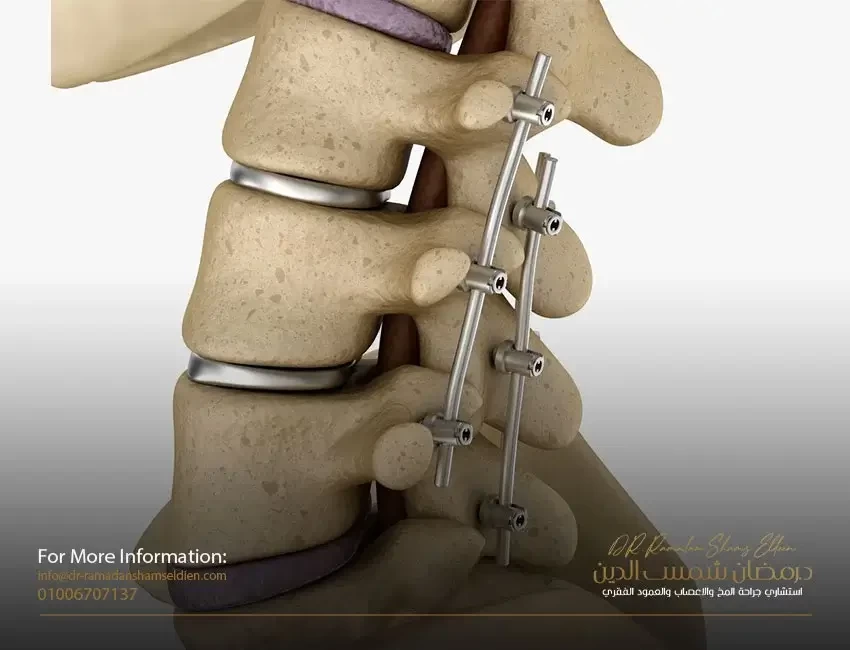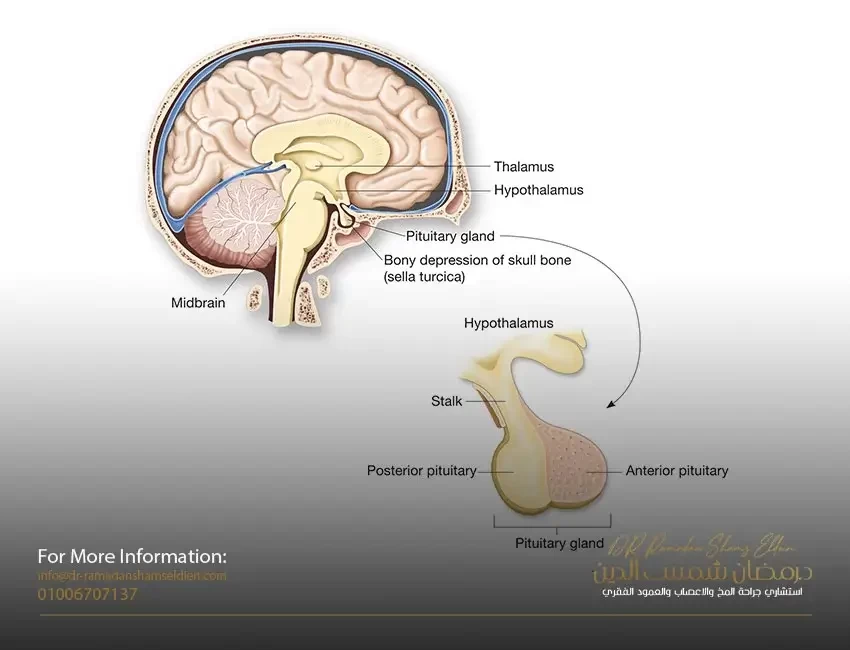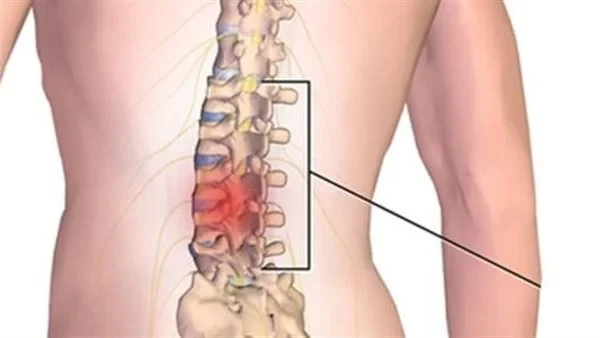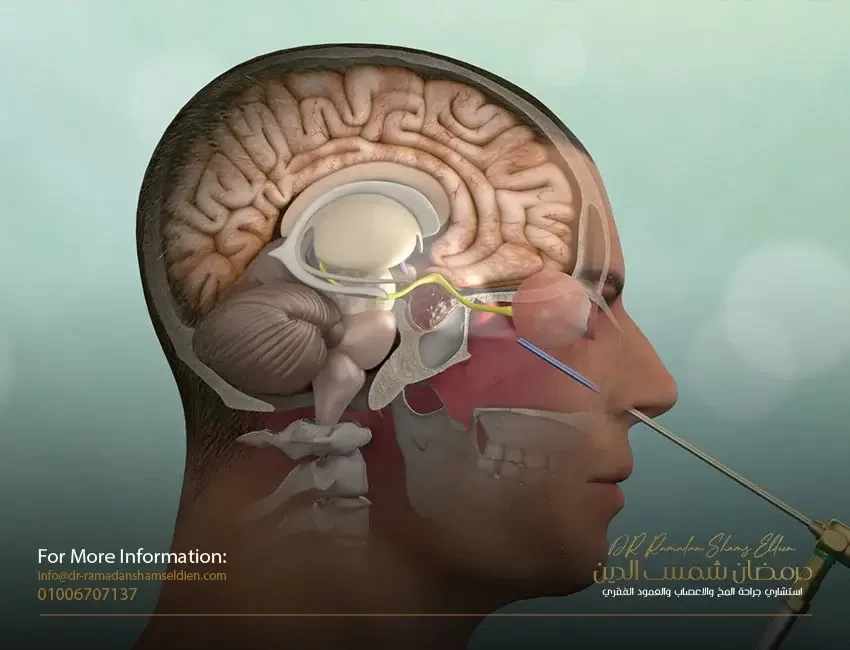الرعاية المنزلية ما بعد الجراحة لحالات استئصال الغدة النخامية عن طريق الانف
headache and pain
You will be given a prescription for pain relief. Pain after pituitary gland surgery is usually easily controlled with this medication.
Don't be afraid to take pain pills if you are uncomfortable, especially when going to bed at night or getting up in the morning.
Sleeping with your head elevated (on at least two pillows) helps reduce pain and swelling.
Do not operate machinery or drive while taking drugs.
If your headache worsens, pain is not relieved by pain relievers, or you feel stiffness and pain in your neck, see a doctor.
Fatigue and stress
It is normal to feel tired after surgery for 3 to 4 weeks.
Increase your activity slowly and remember to rest when you are tired.
Sinus congestion
Don't be discouraged if you can't breathe through your nose at first. It usually takes two to three weeks before the inflammation and swelling within the nose subside enough to provide a good nasal airway.
nasal secretions
You can expect some bloody mucus to come out of your nose. This drainage will be as large as possible for the first three days after surgery. It is best not to blow your nose immediately after surgery as this may cause bleeding.
After 7 days, you can gently clean your nose.
What happens if my nose bleeds?
It is normal to detect red blood or bloody mucus. Bleeding fast, bleeding from the nose that does not stop after a few minutes of sitting and pressing your nose together is not. This rarely happens, and when it does, it is almost always a small vessel in the nose (not the tumor or the brain). Take control with pressure and go to the local emergency room. They may have to stick your nose to stop it.
clean your nose
The best way to clear your nose of dried up mucus and blood is to irrigate with a saline solution (salt water). These waterings are best done with a bottle of NeilMed Sinus Rinse, which you can get at your local pharmacy. Put the contents of one salt packet into the plastic bottle and fill it with lukewarm water. If you run out of refills, you can buy extra supplies at your local pharmacy or you can use a teaspoon of table salt instead. Once the bottle is full, lean against the sink and squeeze the bottle to irrigate each nostril with saline. Use one bottle full of salt water for each nostril. If done correctly, the mucus will be eliminated from the front of the nose. Some of the mucus may drain up the back of the nose and flow out of the other nostril or mouth. This procedure should start on the first day after surgery and be repeated at least twice daily for a week. This watering may seem unusual at first, but soon you will find it relaxing and soothing. You may want to water more than twice a day, and that's fine. Don't worry about cleaning too hard. Watering can be vigorous as long as it does not cause new bleeding.
sneezing and coughing
If you need to sneeze or cough during the two weeks following surgery, stay relaxed and let it happen! Do not hold your breath or pinch your nose!
Avoid things that make you sneeze.
Medications and lab tests
After surgery, you may be prescribed prednisone or dexamethasone. It is important to keep taking this medication daily until you are told to stop.
An endocrinologist will monitor your sodium and hormone levels in the weeks after surgery. They will instruct you on when and where to take the blood tests.
fever
If your fever is higher than 38.5 degrees, double the dose of the steroid until the fever subsides. If the fever exceeds 38.5 degrees during the first two weeks after surgery, contact your doctor.
Nausea and vomiting
If you feel sick and vomit within 4 hours of taking the steroid medicine, go to your local emergency department for an injection of the steroid medicine. Also inform your local endocrinologist/endocrinologist and Dr. Sweringen or Dr. Jones, as you may need to have your sodium level checked.
High sodium in the blood - hypernatremia
If you start urinating excessively and become very thirsty (waking up several times in the night, for example), this may be a temporary condition called diabetes insipidus. The pituitary gland may not produce enough of the hormone that regulates sodium levels in the blood. The level of sodium in your blood may be too high - hypernatremia. This is why we test your blood at regular intervals for the first two weeks after surgery. Contact your local endocrinologist/endocrinologist. Additional blood tests may be ordered. If appropriate, medication may be ordered to control excessive urination and thirst until the pituitary gland resumes normal function. This may take several days. (Diabetes insipidus is not blood sugar)
Hyponatremia - Hyponatremia
If you experience nausea and vomiting, but do not have a fever, you may have a temporary condition called syndrome of inappropriate antidiuretic hormone, or SIADH for short. The pituitary gland may secrete too much of a hormone that regulates sodium levels in the blood. The level of sodium in your blood may be too low - hyponatremia. This is why we test your blood at regular intervals for the first two weeks after surgery. Contact your local endocrinologist/endocrinologist. The doctor may order additional blood tests and, if necessary, may put you on a fluid-restricted diet until the pituitary gland resumes its normal function. This may take several days. Note that severe hyponatremia is dangerous and can cause seizures. Signs of severe hyponatremia include confusion, lethargy, and an inability to stay awake. Seek immediate medical attention - go to your local emergency department - if this occurs.
Abdominal care
A small fat graft has been taken from your belly. Try to keep the incision dry for the first week. Call the doctor if the abdominal incision becomes more painful, hot to the touch, or has redness, swelling, or drainage.
take a shower Mother
You can take a shower at any time. Cover the abdominal incision with plastic when showering for the first week after surgery. You can wet the wound after 7 days.
constipation
Pain relievers may cause constipation. If you become constipated, increase your fiber intake and you may need to take a stool softener.
Bending and lifting
Heavy lifting, stress and exercise that may cause bleeding should be avoided for the first two weeks. Don't be surprised if you tire more easily than usual. Wait about four weeks before resuming a strenuous exercise program.
everyday activities
o In general, you can return to work in two to three weeks depending on the work you do. Sooner if you feel up to it.
o You can run after a month and return to regular exercise after two months.
o You can eat and drink whatever you want.
o You can travel by plane at any time.
o You can drive at any time as long as you are not taking narcotic pain relievers.
o You can swim after two months.
o There are no restrictions on intimacy with your partner.
الرعاية المنزلية بعد عمليات العمود الفقري العنقي
everyday activities
You need to give your body time to recover after this process; And with light activities. You must get out of bed and move around to recover
And reduce the risk of secondary medical problems such as blood clots.
Below is a list of activities that you should pursue.
1. Most of the time you need a neck brace after surgery for three months. You will wear the brace most of the day and even while you sleep for the first two weeks after surgery. You can remove the brace for short periods of time when resting and you can remove the brace for a shower. You cannot drive while wearing this brace.
2. Avoid doing any sports except walking for the first two weeks after surgery. Avoid sweating in the wound area to reduce the risk of infection.
There are no restrictions on taking the stairs or sitting.
3. Sleep in any comfortable position (including the side, back, or stomach)
Activities to avoid
Do not drive while you are given a neck brace to wear.
• Not to lift more than 2 kilograms during the first month after surgery.
Not to lift more than 10 kg for 3 months
• Do not engage in any sexual activity in the first two weeks after surgery.
wound care
Incision care at home is important to prevent infection. Please follow these steps to take care of the surgical incision:
• If you have a dressing over the wound, you can remove it when you are at home
• When you are at home, it is best to leave the incision open to air.
You can cover the wound with a bandage if that is more comfortable, but you need to change the bandage once a day with sterile gauze and surgical betadine.
• You can shower 5 days after the surgery. Do not direct water pressure on the crevice, but the water can roll over the crevice. Dry the incision with a clean towel.
Pain management at home
After surgery, it is normal to feel occasional pain, numbness or tingling in your neck or arm. To reduce pain, there are several methods you can try:
• Take painkillers as directed by your doctor.
• You can use paracetamol to supplement pain control if needed.
NSAIDs, such as diclofen/ibuprofen, may also be used to help reduce inflammation and control pain. Do not exceed the recommended daily dose of these medications.
Narcotic analgesics cause constipation. Eat plenty of foods that contain bran (bran, oats, fruits, apple juice) and drink plenty of fluids. You can also take more than one stool softener.
You will be given a prescription for pain relief after the surgery.
Call your doctor if you have any of the following
1. A temperature (38.5°C) or more in two readings spaced 4 hours apart
2. An increase in pain, redness, or swelling around the wound.
3. Bleeding from the wound incision
4. Increased difficulty breathing or swallowing
5. Difficulty passing urine or controlling bowel movements.
6. Increased swelling in the ankles or feet.
7. Increased weakness of your arms or legs.
8. Redness, warmth and pain on the back of the leg (lower limbs).
future follow-up
Follow-up in the clinic two weeks after surgery
back to work
Your return to work will depend on your recovery and the type of work you do. This should be discussed with your doctor.
الرعاية المنزلية بعد عمليات استئصال الغضروف القطني
Postoperative instructions
Successful surgery depends not only on the success of the procedure, but also on your cooperation and compliance with instructions during the postoperative period.
Here are the instructions and instructions
everyday activities
Walking is the best 'exercise' after surgery and you need to walk daily. Gradually increase the distance you walk until you can walk one mile within one month after surgery.
Do not lift more than 5 kg in the first four weeks after surgery.
Do not bend or twist at the waist during the first 3 months after surgery.
No "special" mattress is required after surgery.
Sleeping on a water bed that does not provide proper spinal support should be avoided.
wound care
Proper incision care helps prevent infection.
Keep the incision dry for five days after surgery.
You can shower and wet the wound after five days
. Avoid rubbing the incision site.
Avoid baths, hot tubs and swimming for a month after surgery.
Do not wash the wound directly. Gently wash the incision with soap and water, then let it air dry.
If you have a fever or chills, take your temperature with a thermometer. If you have a temperature of 38.5 degrees or higher for more than 4 hours, contact us.
Check the incision daily for redness, swelling, or water leakage. Some redness and swelling is normal.
Leaking a small amount of pure or slightly mixed blood from the incision is normal. Call us if the drainage continues for more than 2 days or if you have redness or swelling around the incision.
Do not use any alcohol creams, lotions, or ointments near or over the wound.
Avoid itching at the wound site.
pain reliever
During the recovery phase, it is common to feel some pain, numbness, tingling, and weakness in your back and legs. Nerves generally take longer to heal, so the numbness and tingling can take weeks to months to completely disappear. If you have an increase in pain once you get home, try these options to reduce the pain.
Apply ice to the back for 15-20 minutes every hour for 4 hours. Do not apply ice directly to the skin. Use pre-made ice packs or put ice in a plastic bag. Then wrap the ice pack or bag in a towel before using it.
Reduce your activity during the next 24 hours (ie walking).
You will be discharged with a prescription for your surgical pain.
The goal is to reduce your pain reliever intake for 6 weeks after surgery.
smoking
You must stop smoking.
This increases the chance that your bones will not heal properly.
Smoking reduces the rate of skin and bone healing.
Smoking also interferes with the effectiveness of your pain medications.
This can affect the success of the lumbar discectomy.
constipation
A combination of surgery and pain-relieving medications, a reduced level of activity and a change in your diet may lead to constipation.
After surgery, it's common for you to have a problem with your gut.
Increasing your fiber intake, being mobile, and taking a stool softener will help relieve this.
future follow-up
Follow-up in the clinic two weeks after surgery
Call your doctor if you have any of the following
Excessive redness, swelling, or bleeding in the affected area at the site of the incision, especially swelling around the back wound
If there is leakage from the wound and the leakage continues for more than two days.
If your temperature is 38.5 degrees or lasts longer than 4 hours.
Loss of bladder or bowel control
Redness, warmth, or tenderness in the back of the leg (lower limbs)
A constant headache that varies while you are sitting
نصائح بعد عمليات المخ - الجمجمة
Diet:
You can resume the type of diet you had before the surgery. Eating a balanced diet is important for proper wound healing. Your doctor or nurse will tell you if you need a specific diet or food consistency.
pharmaceutical:
Your doctor will provide you with prescriptions for the medication you are taking
Comfort and Pain Management:
It is common to have a headache/pain after surgery, which may last a few days or a few weeks. You will get pain relievers prescribed to you by your doctor to relieve your pain. The medicine may irritate the stomach lining, and it is recommended to take it with a teaspoon of apple juice or skimmed yogurt. Pain medications (narcotics) may cause constipation. Use a stool softener if this happens.
Eye/face puffiness is common after surgery and may take a few days to a week to go away. Bruising may occur and will take 1-2 weeks to resolve. You may feel better if you sleep with two pillows under your head; Elevating your head will help reduce facial swelling.
everyday activities:
You may feel more tired for 1-3 weeks after surgery.
Get plenty of rest.
Make sure to do a gentle activity, such as walking, every day.
You can resume intimacy when you feel good enough, but don't overburden yourself.
You must get clearance from your doctor before doing any heavy exercise/activity.
Activities to avoid:
Avoid straining, bending at the waist, and high-impact exercises such as running and lifting heavy objects (more than 5 kg) for at least two weeks after surgery.
Resuming work/driving/air travel: You must get permission from your doctor
Before returning to work, driving a car or flying.
Wound care / sutures:
You will likely be taken out with sutures/staples that are still in place.
You can shower within 24 hours after surgery, but do not wet the wounds until 7 days after surgery.
We recommend that you take a shower with someone in the bathroom to help you.
Wash, do not rub the wound. Do not submerge your head under water.
You can leave the wound open for air; However, you can cover the incision with a clean cap, scarf, or hat.
If you have an abdominal or groin incision, keep the area clean and open to air. Cover it with plastic wrap before showering.
You may gently wash your abdominal or groin incision with soap and water 5 days after surgery.
Follow up date:
Follow-up in the clinic two weeks after surgery
Call your doctor if you have any of the following
The appearance of a severe and persistent headache that is not relieved by medication and rest
Onset of increased drowsiness and confusion
Nausea, vomiting, or diarrhea
Appearance or worsening of visual problems
Onset or worsening of speech problems
Appearance or increase in weakness, numbness or tingling
Onset or worsening of seizures
Fever onset with more than 38.5 degrees, persistent chills, or stiff neck
Any redness, bleeding, heat, pain, or increased swelling around the wound
Shortness of breath, chest pain, pain or swelling on one side of the leg (lower limbs)
تعليمات يجب اتباعها من الأدوية قبل الجراحة
What are the instructions to be followed for the usual medications from the patient before surgery?
• Before proceeding to the surgery, any non-steroidal anti-inflammatory drugs such as: Ibuprofen, Naprosyn, Celebrex, Mobic, Indoside and Diclofen should be discontinued. 7 days before surgery.
• Also, you will need to stop taking aspirin and any anticoagulants (to help with fluidity), including clopidogrel and marivan (7 to 10) days before the date of the intervention.
• Please stop taking herbal and vitamin supplements for the same period (7-10) days prior to surgery including but not limited to, ginseng, ginkgo biloba, vitamin E and vitamin C.
• Diabetics should not take any oral hypoglycemic drugs and switch to insulin instead of tablets 5 to 3 days before the surgical procedure.
• You should not take any diuretics on the morning of the surgery (eg Lasix) unless the patient has congestive heart failure.
• You should not take any of the classes of antihypertensive drugs, which include the following examples: Lisinopril, Lotril, Captopril, Lotensin, Monopril, Brinzide, Atacand, Benicar, Diovan and Avalid.







